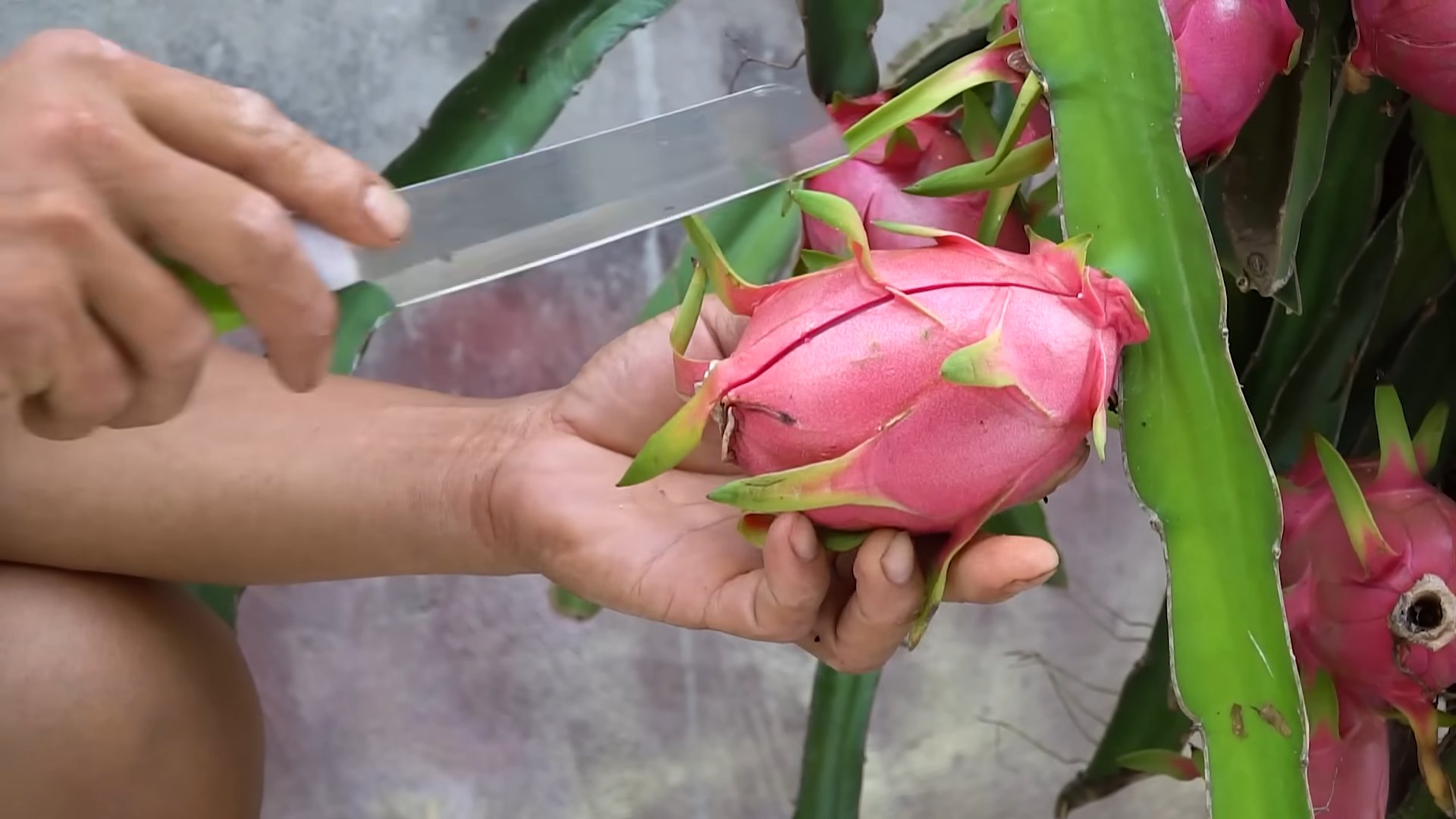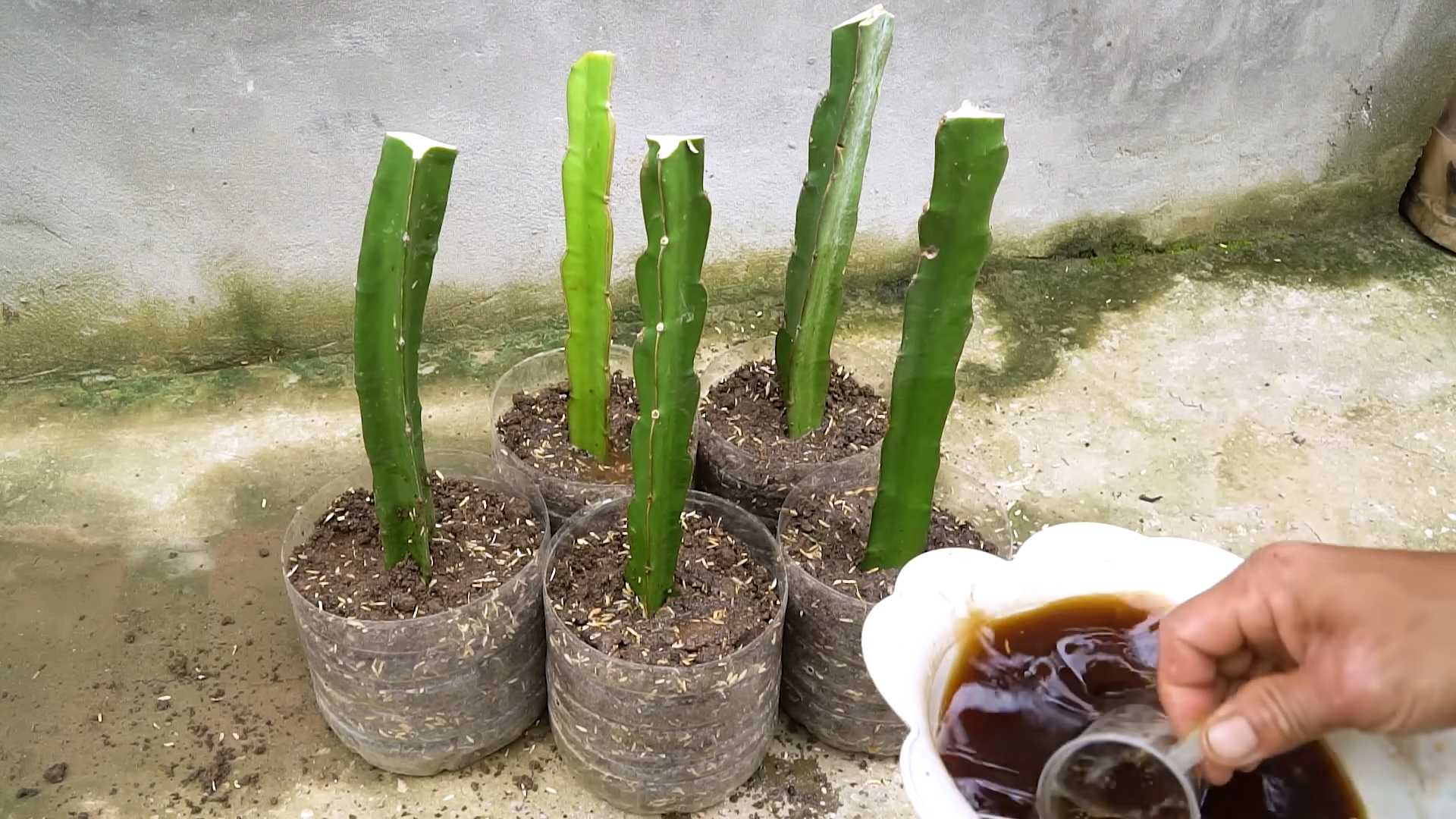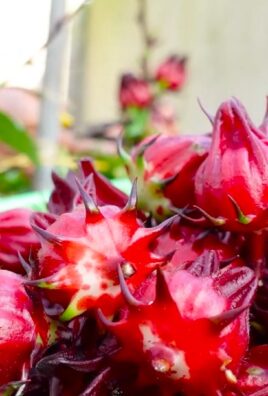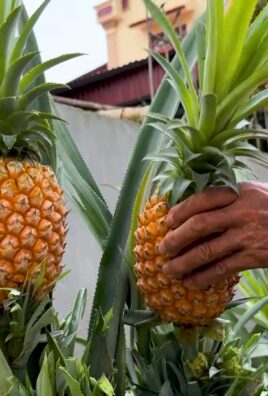Grow Dragonfruit at Home? Absolutely! Imagine plucking a vibrant, exotic dragon fruit, bursting with flavor, straight from your own backyard. Sounds like a tropical dream, right? Well, it’s more achievable than you might think! For centuries, dragon fruit, also known as pitaya, has been cultivated in Southeast Asia and Latin America, prized not only for its delicious taste but also for its stunning appearance. Now, you can bring a touch of that exotic charm to your own home garden.
But why bother with the effort? Well, store-bought dragon fruit can be expensive and sometimes lack the freshness and flavor of homegrown varieties. Plus, there’s immense satisfaction in nurturing a plant from a small cutting to a fruit-bearing beauty. I’m here to guide you through some simple yet effective DIY tricks and hacks that will make growing dragonfruit at home a rewarding and surprisingly easy experience. Whether you have a sprawling garden or just a sunny balcony, I’ll show you how to create the perfect environment for your dragon fruit to thrive. Get ready to embark on a fun and fruitful journey!

Grow Your Own Dragon Fruit: A Comprehensive DIY Guide
Hey there, fellow plant enthusiasts! Ever dreamt of harvesting your own exotic dragon fruit right in your backyard (or even indoors)? Well, dream no more! I’m going to walk you through everything you need to know to successfully grow dragon fruit at home. It might seem intimidating, but trust me, with a little patience and the right guidance, you’ll be enjoying delicious, homegrown dragon fruit before you know it.
Choosing the Right Dragon Fruit Variety
First things first, let’s talk varieties. Dragon fruit comes in several types, each with its own unique flavor and appearance. Some popular choices include:
* White-fleshed varieties (like ‘Hylocereus undatus’): These are the most common, with a mild, slightly sweet flavor. They’re a great starting point for beginners.
* Red-fleshed varieties (like ‘Hylocereus costaricensis’): These have a more vibrant color and a slightly tangier, richer flavor.
* Yellow-fleshed varieties (like ‘Hylocereus megalanthus’): These are known for their sweetness and are often considered the most flavorful.
Consider your climate and taste preferences when choosing a variety. Some varieties are more cold-hardy than others, so do your research!
Getting Started: Propagation Methods
You have two main options for starting your dragon fruit journey: seeds or cuttings. While seeds are an option, I highly recommend using cuttings. They’re faster, more reliable, and you’ll know exactly what kind of fruit you’re going to get.
Propagation from Cuttings
This is my preferred method, and here’s how I do it:
1. Source Your Cuttings: Find a healthy, mature dragon fruit plant and ask if you can take a cutting. Look for segments that are at least 12 inches long and free from any signs of disease or damage. You can often find cuttings online from reputable sellers as well.
2. Prepare the Cuttings: Once you have your cutting, let it callous over for about a week. This helps prevent rot when you plant it. Simply place the cutting in a dry, shaded area. You’ll notice the cut end will start to dry and harden.
3. Potting Mix: Dragon fruit needs well-draining soil. I like to use a mix of cactus potting mix, perlite, and a little bit of compost. This combination provides good drainage and nutrients.
4. Planting the Cutting: Fill a pot (at least 6 inches in diameter) with your potting mix. Make a hole in the center and insert the calloused end of the cutting about 2-3 inches deep.
5. Watering: Water the cutting thoroughly after planting, but then let the soil dry out almost completely before watering again. Overwatering is a dragon fruit’s worst enemy!
6. Location: Place the pot in a warm, sunny location. Dragon fruit loves sunlight! Aim for at least 6 hours of direct sunlight per day.
7. Patience is Key: It can take several weeks for the cutting to root. Be patient and keep the soil lightly moist (but not soggy). You’ll know it’s rooted when you see new growth emerging.
Propagation from Seeds (Less Recommended)
If you’re feeling adventurous, you can try growing dragon fruit from seeds. Keep in mind that it takes longer and the resulting plant may not be true to the parent plant.
1. Extract the Seeds: Cut open a ripe dragon fruit and scoop out the pulp.
2. Clean the Seeds: Separate the seeds from the pulp by rinsing them thoroughly with water.
3. Dry the Seeds: Spread the seeds on a paper towel and let them dry completely.
4. Sow the Seeds: Fill a small pot with seed-starting mix. Sprinkle the seeds on top of the soil and lightly cover them with more mix.
5. Watering: Mist the soil gently with water.
6. Humidity: Cover the pot with plastic wrap to create a humid environment.
7. Location: Place the pot in a warm, sunny location.
8. Germination: The seeds should germinate in about 1-2 weeks.
9. Transplanting: Once the seedlings are large enough to handle, transplant them into individual pots.
Caring for Your Dragon Fruit Plant
Once your dragon fruit plant is established, it’s time to focus on providing the right care to help it thrive.
1. Sunlight: Dragon fruit needs plenty of sunlight. Aim for at least 6 hours of direct sunlight per day. If you’re growing it indoors, place it near a sunny window or use a grow light.
2. Watering: Water your dragon fruit plant deeply when the soil is dry to the touch. Avoid overwatering, as this can lead to root rot. During the winter months, reduce watering frequency.
3. Fertilizing: Feed your dragon fruit plant with a balanced fertilizer every 2-3 months during the growing season (spring and summer). I like to use a fertilizer that’s specifically formulated for cacti and succulents.
4. Support Structure: Dragon fruit is a climbing cactus, so it needs a support structure to grow on. A sturdy trellis, post, or even a large tomato cage will work. As the plant grows, tie the stems to the support structure.
5. Pruning: Prune your dragon fruit plant regularly to encourage branching and fruit production. Remove any dead or damaged stems. You can also prune to control the size and shape of the plant.
6. Temperature: Dragon fruit thrives in warm temperatures (65-80°F). It can tolerate temperatures as low as 32°F for short periods, but it’s best to protect it from frost.
7. Pests and Diseases: Dragon fruit is relatively pest-resistant, but it can be susceptible to mealybugs, aphids, and scale. Inspect your plant regularly and treat any infestations promptly. Root rot is a common problem caused by overwatering.
Pollination: Helping Your Dragon Fruit Produce Fruit
Dragon fruit flowers are nocturnal, meaning they bloom at night. They’re also self-incompatible, which means they need to be cross-pollinated with another variety to produce fruit.
1. Hand-Pollination: If you only have one dragon fruit plant, you’ll need to hand-pollinate the flowers. Use a small paintbrush to transfer pollen from the stamen (the male part of the flower) to the pistil (the female part of the flower). Do this at night when the flowers are open.
2. Attracting Pollinators: If you have multiple dragon fruit plants, you can try attracting pollinators like bats and moths to your garden. Plant fragrant flowers that bloom at night and avoid using pesticides.
Harvesting Your Dragon Fruit
It typically takes 6-8 months for dragon fruit to mature after flowering. Here’s how to know when it’s ready to harvest:
1. Color: The fruit will turn from green to its mature color (red, pink, or yellow, depending on the variety).
2. Texture: The skin will be slightly soft to the touch.
3. “Wings”: The “wings” or bracts on the fruit will start to dry and wither.
To harvest, simply twist the fruit off the plant. Enjoy your homegrown dragon fruit!
Troubleshooting Common Problems
Even with the best care, you might encounter some challenges along the way. Here are a few common problems and how to address them:
* Yellowing Leaves: This could be a sign of overwatering, underwatering, or nutrient deficiency. Adjust your watering schedule and fertilize your plant if needed.
* Root Rot: This is caused by overwatering. Make sure your soil is well-draining and avoid watering too frequently. If you suspect root rot, repot the plant in fresh soil.
* Lack of Flowering: This could be due to insufficient sunlight, lack of nutrients, or improper pruning. Make sure your plant is getting enough sunlight, fertilize it regularly, and prune it properly.
* Pests: Inspect your plant regularly for pests and treat any infestations promptly.
Growing Dragon Fruit Indoors
While dragon fruit thrives outdoors, it can also be grown indoors with the right conditions.
1. Pot Size: Choose a large pot (at least 12 inches in diameter) with drainage holes.
2. Potting Mix: Use a well-draining potting mix, such as cactus potting mix.
3. Sunlight: Place the pot near a sunny window or use a grow light to provide at least 6 hours of light per day.
4. Watering: Water the plant when the soil is dry to the touch. Avoid overwatering.
5. Fertilizing: Fertilize the plant every 2-3 months during the growing season.
6. Support

Conclusion
So, there you have it! Growing dragon fruit at home might seem like an exotic endeavor reserved for tropical climates, but with a little know-how and dedication, you can absolutely cultivate these vibrant and delicious fruits right in your own backyard or even indoors. This DIY trick isn’t just about saving money; it’s about connecting with nature, understanding the growth cycle of a fascinating plant, and enjoying the unparalleled satisfaction of harvesting your own homegrown produce.
Why is this a must-try? Because the flavor of a freshly picked, homegrown dragon fruit is simply unmatched. The subtle sweetness, the refreshing texture, and the sheer novelty of it all make it an experience worth pursuing. Beyond the taste, you’re also gaining a beautiful and unique plant that will add a touch of the tropics to your home or garden. Dragon fruit plants are visually stunning, with their sprawling, cactus-like stems and magnificent, nocturnal blooms.
But the benefits don’t stop there. By growing your own dragon fruit, you’re reducing your carbon footprint by eliminating the need for long-distance transportation. You’re also ensuring that your fruit is free from harmful pesticides and chemicals, giving you complete control over its quality. Plus, it’s a fantastic conversation starter! Imagine the look on your friends’ faces when you offer them a slice of dragon fruit you grew yourself.
Ready to take your dragon fruit cultivation to the next level? Consider these variations and suggestions:
* Experiment with different varieties: Dragon fruit comes in a range of colors and flavors, from the classic white-fleshed variety to the more exotic red and yellow types. Try growing a few different varieties to discover your personal favorite.
* Optimize your soil mix: While the basic mix we discussed works well, you can further enhance it by adding compost, worm castings, or other organic matter to provide your plant with even more nutrients.
* Get creative with trellising: Dragon fruit plants need support to climb, so get creative with your trellising system. You can use a simple wooden stake, a sturdy trellis, or even a repurposed metal structure.
* Consider hydroponics: For those with limited space or a penchant for experimentation, dragon fruit can also be grown hydroponically. This method involves growing the plant in a nutrient-rich water solution without soil.
* Pollination Assistance: While dragon fruit are self-pollinating, you can increase your yield by hand-pollinating the flowers, especially if you are growing indoors or in an area with limited pollinator activity. Use a small, soft brush to transfer pollen from the stamen to the pistil.
We’re confident that you’ll find growing dragon fruit at home to be a rewarding and enjoyable experience. Don’t be afraid to experiment, learn from your mistakes, and most importantly, have fun!
Now, we encourage you to embark on this exciting journey and discover the joys of homegrown dragon fruit. We’re eager to hear about your experiences! Share your photos, tips, and challenges in the comments below. Let’s create a community of dragon fruit enthusiasts and help each other succeed in this rewarding endeavor. Remember, the key to success is patience, persistence, and a little bit of love. Happy growing! This DIY trick will bring you closer to nature.
Frequently Asked Questions (FAQ)
Q: How long does it take for a dragon fruit plant to produce fruit?
A: Dragon fruit plants typically take 6-18 months to begin producing fruit from cuttings. Plants grown from seed can take significantly longer, sometimes up to 5-7 years. The time to fruiting also depends on factors such as the variety, climate, and growing conditions. Providing optimal care, including adequate sunlight, water, and nutrients, will help your plant fruit sooner.
Q: What kind of soil is best for dragon fruit?
A: Dragon fruit plants thrive in well-draining soil that is rich in organic matter. A good mix consists of equal parts potting soil, sand, and compost. The sand helps with drainage, while the compost provides essential nutrients. Avoid heavy clay soils, as they can retain too much moisture and lead to root rot. You can also amend your soil with perlite or vermiculite to improve drainage and aeration.
Q: How much sunlight does a dragon fruit plant need?
A: Dragon fruit plants need at least 6-8 hours of direct sunlight per day to thrive and produce fruit. In hotter climates, some afternoon shade may be beneficial to prevent sunburn. If you’re growing your dragon fruit plant indoors, place it near a sunny window or supplement with grow lights. Insufficient sunlight can lead to stunted growth and reduced fruit production.
Q: How often should I water my dragon fruit plant?
A: Dragon fruit plants are drought-tolerant and do not like to be overwatered. Water thoroughly when the top inch of soil feels dry to the touch. During the growing season (spring and summer), you may need to water more frequently than during the dormant season (fall and winter). Ensure that your pot has drainage holes to prevent water from accumulating at the bottom.
Q: What kind of fertilizer should I use for dragon fruit?
A: Dragon fruit plants benefit from regular fertilization, especially during the growing season. Use a balanced fertilizer with an NPK ratio of 10-10-10 or 20-20-20. You can also use a fertilizer specifically formulated for cacti and succulents. Apply the fertilizer according to the package instructions, typically every 2-4 weeks. Avoid over-fertilizing, as this can damage the plant.
Q: How do I prune my dragon fruit plant?
A: Pruning is essential for maintaining the shape and health of your dragon fruit plant. Remove any dead, damaged, or diseased stems. You can also prune to control the size and shape of the plant. Prune after the fruiting season to encourage new growth. Use clean, sharp pruning shears to avoid spreading disease.
Q: How do I protect my dragon fruit plant from pests and diseases?
A: Dragon fruit plants are generally resistant to pests and diseases, but they can be susceptible to certain problems. Common pests include aphids, mealybugs, and spider mites. These can be controlled with insecticidal soap or neem oil. Root rot is a common disease caused by overwatering. Prevent root rot by ensuring that your soil is well-draining and avoiding overwatering.
Q: Can I grow dragon fruit indoors?
A: Yes, you can grow dragon fruit indoors, but it requires some extra care. Provide your plant with plenty of sunlight, either from a sunny window or grow lights. Use a well-draining potting mix and water sparingly. You may also need to hand-pollinate the flowers to ensure fruit production. Choose a pot that is large enough to accommodate the plant’s root system.
Q: How do I know when my dragon fruit is ripe?
A: A ripe dragon fruit will have a vibrant, even color and will feel slightly soft to the touch. The “wings” or scales on the fruit will also start to dry out and turn brown. Gently twist the fruit; if it comes off easily, it’s ripe. Avoid picking the fruit too early, as it will not ripen further off the vine.
Q: What are some common problems when growing dragon fruit and how do I fix them?
A: Some common problems include yellowing leaves (often due to overwatering or nutrient deficiency), lack of flowering (insufficient sunlight or improper fertilization), and fruit drop (inadequate pollination or stress). Adjust your watering and fertilization practices as needed. Ensure your plant receives enough sunlight. If fruit drop is a problem, try hand-pollinating the flowers.




Leave a Comment